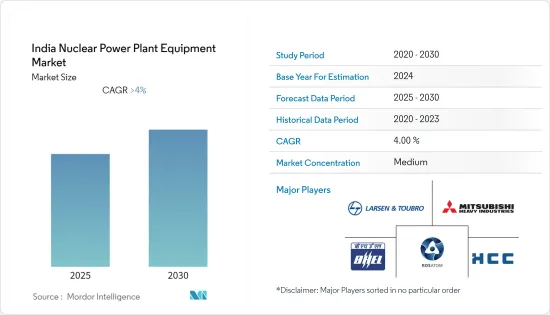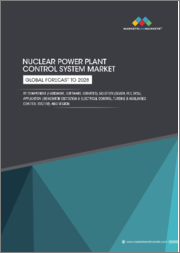
|
시장보고서
상품코드
1630435
인도의 원자력발전소 설비 : 시장 점유율 분석, 산업 동향 및 통계, 성장 예측(2025-2030년)India Nuclear Power Plant Equipment - Market Share Analysis, Industry Trends & Statistics, Growth Forecasts (2025 - 2030) |
||||||
인도의 원자력발전소 설비 시장, 예측 기간 동안 CAGR 4% 이상 기록할 것으로 예상됩니다.

COVID-19는 2020년 시장에 부정적인 영향을 미쳤습니다. 현재 시장은 전염병 이전 수준에 도달할 가능성이 높습니다.
주요 하이라이트
- 중기적으로는 온실가스 감축과 동시에 인구 증가에 따른 에너지 수요 증가와 지속가능한 시장 개척 지원에 원자력이 크게 기여하는 것이 시장을 주도하고 있습니다.
- 반면, 태양광, 풍력 등 대체 청정에너지원에 대한 투자 증가는 예측 기간 동안 시장 성장을 억제할 것으로 예상됩니다.
- 고속증식로와 같은 새로운 원자로 설계의 상용화를 위한 연구개발은 예측 기간 이후에도 시장에 큰 기회가 될 것으로 예상됩니다.
인도의 원자력발전소 설비 시장 동향
가압수형 중수로가 시장을 독식
- 가압수형 원자로는 일반적으로 농축되지 않은 천연 우라늄 산화물을 연료로 사용하기 때문에 냉각재로 더 효율적인 중수를 필요로 합니다. 중수는 중성자 경제성을 높이고 연료 농축 시설 없이도 원자로를 운전할 수 있으며, 원자로가 대체 연료 사이클을 사용할 수 있게 해줍니다.
- PHWR의 설계는 PWR과 달리 얇은 벽의 압력 파이프가 필요합니다. 이를 통해 압력 경계를 다수의 소구경 압력관에 분산시킬 수 있습니다. 결과적으로 이 설계는 PWR 설계에 비해 압력 경계가 우발적으로 파열될 가능성이 낮습니다. 따라서 PHWR은 PWR 플랜트보다 더 안전한 것으로 간주됩니다.
- 2021년 2월 현재 인도에는 총 발전용량 5080MW의 PHWR 18기가 가동 중이며, 그 중 220MW 15기, 540MWe 2기, 700MWe 1기가 가동 중입니다.
- 2021년 1월, IPHWR-700형 원자로의 첫 국산 모델인 카클라파르 3호기가 처음으로 송전망에 동기화되었고, 2022년 5월 현재 700MWe의 자체 설계 원자로 5기가 다양한 건설 단계에 있습니다.
- 또한, 국내에는 10기의 원자로가 추가로 계획되어 있습니다. 전 세계적으로 4기의 원자로가 건설 중입니다. 이들 원자로는 모두 인도 국영 전력공사가 건설 중이며, 카클라파르에 2기, 라자스탄에 2기가 건설 중입니다. 이 원자로의 예상 용량은 약 2.8GWe입니다.
- 따라서 이러한 인도의 발전은 예측 기간 동안 인도의 원자력발전소 장비 시장을 뒷받침할 것으로 예상됩니다.
시장 독식하는 섬 설비
- 섬 설비 카테고리의 주요 설비는 원자력 증기 공급 시스템(NSSS)과 안전 시스템입니다. 원자력 증기 공급 시스템에는 노심, 제어 시스템, 원자로 냉각재 펌프(RCP), 1차측 배관, 1차측 냉각재 압력을 제어하기 위한 가압기(PWR에서만 사용) 등이 포함됩니다. 또한, 1차측 회로와 2차측 회로 간의 열교환을 위한 증기발생기도 있습니다.
- 중앙전력청 통계에 따르면 2022년까지 인도의 원자력발전 설비 용량은 약 6,780MW에 달할 것으로 예상됩니다. 원자력 에너지는 인도의 전력 믹스에서 중요한 에너지원 중 하나입니다.
- 2021년 현재 인도의 원자력발전 설비용량은 약 6억 8,000만kW이며, 2022년 12월 현재 약 8억 7,000만kW가 건설 중이고 8,000만kW 이상이 계획 및 제안되어 있습니다. 원자력이 차지하는 설비용량 비중은 작지만, 청정에너지에 대한 수요가 증가함에 따라 정부는 새로운 원자력발전소 시설 개발에 많은 투자를 할 것으로 예상됩니다. 향후 예정된 프로젝트에 따라 섬 지역 설비 수요는 크게 증가할 것으로 예상됩니다.
- 이미 건설 중인 원자력발전소 프로젝트가 지연되고 있지만 향후 10년간 가동될 것으로 예상됩니다. 정부는 2050년까지 국내 전력의 25%를 원자력으로 조달할 계획이며, 이 목표에 따라 프로젝트 파이프라인이 강화되어 예측 기간 동안 시장을 크게 견인할 것입니다.
- 2022년 3월, 인도 정부는 2023년부터 함대 방식으로 PHWR 건설을 시작할 계획을 발표했으며, 2023년 Kaiga 5호기 및 6호기의 첫 번째 콘크리트, 2024년 Gorakhpur Haryana Anu Vidyut Praiyonjan 3호기, 2024년 Gorakhpur Haryana Anu Vidyut Praiyonjan 3호기 및 4호기, Mahi Banswara Rajasthan Atomic Power Projects 1-4호기, 2025년 Chutka Madhya Pradesh 1, 2호기가 예정되어 있습니다.
- 지난 9월 BHEL은 1,080억 인도 루피에 고락푸르 4기, 카이가 2기 등 총 6기의 원자력 가압경수로(PHWR) 터빈섬을 수주했습니다.
- 또한 2021년 7월 Bharat Heavy Electricals Ltd(BHEL)는 고락푸르와 카이가를 포함한 4곳에 건설될 70만MWe 규모의 인도 설계 PHWR 증기발생기 12기를 공급하는 140억 인도 루피 규모의 계약을 수주했습니다. 인도의 이러한 대규모 PHWR 원자로 투자는 예측 기간 동안 PHWR 발전소 설비에 대한 수요를 증가시킬 것으로 예상됩니다.
- 따라서 위의 점을 고려하면, 예측 기간 동안 섬 장비가 시장을 독점할 가능성이 높습니다.
인도의 원자력발전소 설비 산업 개요
인도의 원자력발전소 설비 시장은 비교적 통합된 시장입니다. 이 시장의 주요 기업들(순서에 관계없이)은 Larsen &Toubro Ltd, Rosatom State Atomic Energy Corporation, Hindustan Construction Company, Bharat Heavy Electricals Limited, 미쓰비시 중공업 등이 있습니다.
기타 혜택
- 엑셀 형식의 시장 예측(ME) 시트
- 3개월간의 애널리스트 지원
목차
제1장 소개
- 조사 범위
- 시장 정의
- 조사 가정
제2장 조사 방법
제3장 주요 요약
제4장 시장 개요
- 소개
- 2028년까지 시장 규모와 수요 예측(단위 : 10억 달러)
- 최근 동향과 개발
- 정부 규제와 시책
- 시장 역학
- 성장 촉진요인
- 성장 억제요인
- 공급망 분석
- PESTLE 분석
제5장 시장 세분화
- 원자로 유형
- 가압수형 원자로
- 가압수형 중수로
- 기타 원자로 유형
- 캐리어 유형
- 섬 설비
- 보조 장비
- 연구로
제6장 경쟁 구도
- M&A, 합작투자, 제휴, 협정
- 주요 기업의 전략
- 기업 개요
- Westinghouse Electric Company LLC
- Doosan Corporation
- Hindustan Construction Company
- Larsen & Toubro Ltd
- Dongfang Electric Corp. Limited
- Bharat Heavy Electricals Limited
- Mitsubishi Heavy Industries Ltd
- Rosatom State Atomic Energy Corporation
제7장 시장 기회와 향후 동향
ksm 25.01.23The India Nuclear Power Plant Equipment Market is expected to register a CAGR of greater than 4% during the forecast period.

COVID-19 negatively impacted the market in 2020. Presently the market is likely to reach pre-pandemic levels.
Key Highlights
- Over the medium term, the significant contribution of nuclear energy in reducing GHG emissions while fulfilling the increasing energy demands of a growing population and supporting sustainable development is driving the market.
- On the other hand, rising investments in alternative clean energy sources such as solar and wind are expected to restrain the market's growth during the forecast period.
- Nevertheless, the research and development into commercializing new nuclear reactor designs, such as Fast Breeder Reactor, is expected to be a significant opportunity for the market beyond the forecast period.
India Nuclear Power Plant Equipment Market Trends
Pressurized Heavy Water Reactors to Dominate the Market
- PHWRs generally use unenriched natural uranium oxide as fuel and, therefore, need more efficient heavy water as the coolant. The heavy water enhances the neutron economy and allows the reactor to operate without fuel enrichment facilities, enabling the reactor to use alternate fuel cycles.
- The PHWR design requires thin-walled pressure tubes, unlike PWR nuclear plants. This allows the distribution of pressure boundaries in many small-diameter pressure tubes. As a result, this design has a lesser chance of accidental rupture of a pressure boundary compared to PWR designs. Therefore, PHWR is considered safer than PWR plants.
- India is the second-largest market for PHWR technology globally, trailing behind only Canada, and as of February 2021, India operates 18 PHWR units with a total capacity of 5080 MW, of which consists of 15 of 220 MW, two units of 540 MWe, and 1 unit of 700 MWe.
- In January 2021, Kakrapar-3, the first indigenously developed IPHWR-700 reactor model, was synchronized with the grid for the first time. As of May 2022, 5 indigenously-designed PHWR units, each of 700 MWe, are in various stages of construction.
- Additionally, ten other PHWR reactors are planned in the country. Globally, there are four under-construction PHWRs. All these PHWRs are being constructed by the National Power Corporation of India, with 2 in Kakrapar and 2 in Rajasthan. The estimated capacity of these reactors will be around 2.8 GWe.
- Thus, such developments in the country are expected to support the India nuclear power plant equipment market during the forecast period.
Island Equipment to Dominate the Market
- The major equipment under the island equipment category is the nuclear steam supply system (NSSS) and safety system. The nuclear steam supply system includes reactors that contain the reactor core, control system, reactor coolant pumps (RCP), primary piping, pressurizer for controlling the pressure of primary coolant (only used in PWR). It also consists of steam generators for heat exchange between the primary circuit and the secondary circuit.
- As per Central Electricity Authority statistcs, by Mrch 2022, India's nuclear energy installed capacity accounts for about 6,780 MW. Nuclear energy is one of the significant energy sources in India's electricty mix.
- India had nearly 6.8 GW of installed nuclear capacity as of 2021, and as of December 2022, around 8.7 GW net capacity under construction and over 80 GW planned or proposed. Depsite the fact that nuclear energy makes up a small share of the country's installed capacity mix, with rising demand for clean energy, the government is expected to invest significantly in the development of new nuclear power plant facilities. With upcoming projects, the demand for island equipment is likely to grow significantly.
- Those nuclear projects already under construction are expected to come online over the next ten years, albeit delayed. The government plans to source 25% of the country's electricity from nuclear energy by 2050, up from the current level of 2.5% - and the project pipeline strengthened in line with these targets, driving the market considerably in the forecast period.
- In March 2022, the Indian government announced that it planned to start the construction of PHWRs in fleet mode from 2023. The first concrete for Kaiga units 5 and 6 is expected in 2023, followed by Gorakhpur Haryana Anu Vidyut Praiyonjan units 3 and 4 and Mahi Banswara Rajasthan Atomic Power Projects units 1-4 in 2024 and Chutka Madhya Pradesh units 1 and 2 in 2025
- In September 2021, BHEL received orders worth INR 108 billion for turbine islands for six nuclear power pressurized heavy water reactor (PHWR) units, 4 at Gorakhpur and 2 at Kaiga, which is the largest order in BHEL's history.
- Additionally, in July 2021, Bharat Heavy Electricals Ltd (BHEL) received an INR 14 billion contract to supply twelve 700MWe Indian-designed PHWR steam generators to be built at four sites including Gorakhpur and Kaiga. Such large investments in PHWR reactors by India is expected to push the demand for PHWR power plant equipment during the forecast period.
- Therefore considering the above-mentioned points, island equipment is likely to dominate the market during the forecast period.
India Nuclear Power Plant Equipment Industry Overview
The India nuclear power plant equipment market is moderately consolidated in nature. Some of the major players in the market (in no particular order) include Larsen & Toubro Ltd, Rosatom State Atomic Energy Corporation, Hindustan Construction Company, Bharat Heavy Electricals Limited, and Mitsubishi Heavy Industries.
Additional Benefits:
- The market estimate (ME) sheet in Excel format
- 3 months of analyst support
TABLE OF CONTENTS
1 INTRODUCTION
- 1.1 Scope of Study
- 1.2 Market Definiton
- 1.3 Study Assumptions
2 RESEARCH METHODOLOGY
3 EXECUTIVE SUMMARY
4 MARKET OVERVIEW
- 4.1 Introduction
- 4.2 Market Size and Demand Forecast in USD billion, till 2028
- 4.3 Recent Trends and Developments
- 4.4 Government Policies and Regulations
- 4.5 Market Dynamics
- 4.5.1 Drivers
- 4.5.2 Restraints
- 4.6 Supply Chain Analysis
- 4.7 PESTLE Analysis
5 MARKET SEGMENTATION
- 5.1 Reactor Type
- 5.1.1 Pressurized Water Reactor
- 5.1.2 Pressurized Heavy Water Reactor
- 5.1.3 Other Reactor Types
- 5.2 Carrier Type
- 5.2.1 Island Equipment
- 5.2.2 Auxiliary Equipment
- 5.2.3 Research Reactor
6 COMPETITIVE LANDSCAPE
- 6.1 Mergers and Acquisitions, Joint Ventures, Collaborations, and Agreements
- 6.2 Strategies Adopted by Leading Players
- 6.3 Company Profiles
- 6.3.1 Westinghouse Electric Company LLC
- 6.3.2 Doosan Corporation
- 6.3.3 Hindustan Construction Company
- 6.3.4 Larsen & Toubro Ltd
- 6.3.5 Dongfang Electric Corp. Limited
- 6.3.6 Bharat Heavy Electricals Limited
- 6.3.7 Mitsubishi Heavy Industries Ltd
- 6.3.8 Rosatom State Atomic Energy Corporation


















